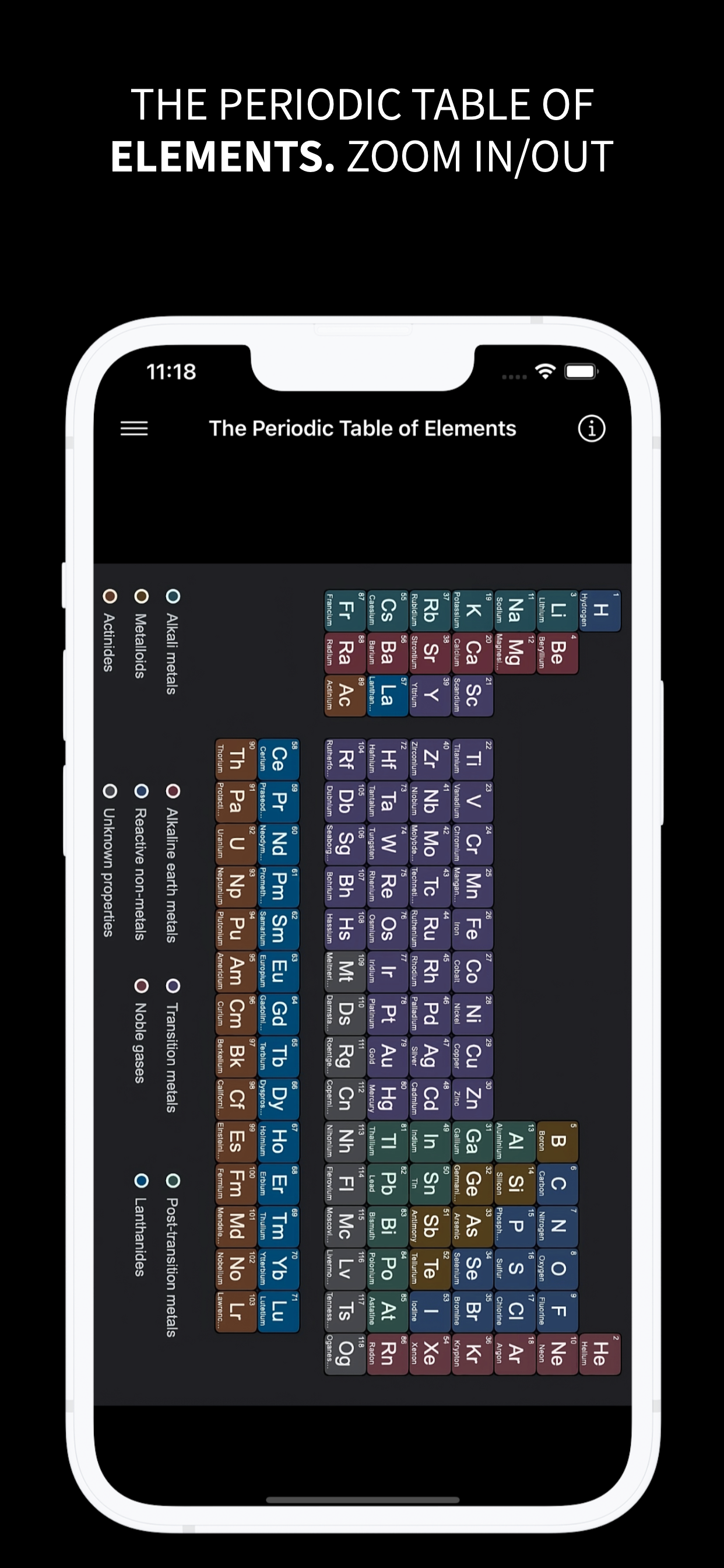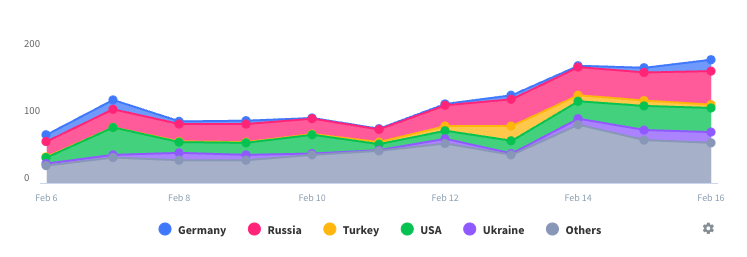
Description
Put your knowledge of the periodic table to the test with this entertaining chemical elements quiz app!
Unlike other apps where you're presented with options where you can make mere guesses, this app demands that you type the name of the chemical element of the periodic table! Study the elements then take the quiz.
How to play:
1. Start by typing the element's name. Once you're done, dismiss the keyboard by clicking return or by tapping any part of the screen. Next, click the "Show Answer" button to reveal the name of the chemical element to verify your answer. If your input matches the chemical element's name, you win, otherwise no!
2. Click the "Next Element" button to go to the next element.
3. Turn on "Randomize" switch to get the chemical elements randomly.
In 1789, French chemist Antoine Lavoisier tried grouping the elements as metals and nonmetals. Forty years later, German physicist Johann Wolfang Döbereiner observed similarities in physical and chemical properties of certain elements. He arranged them in groups of three in increasing order of atomic weight and called them triads, observing that some properties of the middle element, such as atomic weight and density, approximated the average value of these properties in the other two in each triad.
A breakthrough came with the publication of a revised list of elements and their atomic masses at the first international conference of chemistry in Karlsruhe, Germany, in 1860. They concluded that hydrogen would be assigned the atomic weight of 1 and the atomic weight of other elements would be decided by comparison with hydrogen. For example, carbon, being 12 times heavier than hydrogen, would have an atomic weight of 12.
British chemist John Newlands was the first to arrange the elements into a periodic table with increasing order of atomic masses. He found that every eight elements had similar properties and called this the law of octaves. He arranged the elements in eight groups but left no gaps for undiscovered elements.
In 1869, Russian chemist Dmitri Mendeleev created the framework that became the modern periodic table, leaving gaps for elements that were yet to be discovered. While arranging the elements according to their atomic weight, if he found that they did not fit into the group he would rearrange them. Mendeleev predicted the properties of some undiscovered elements and gave them names such as "eka-aluminium" for an element with properties similar to aluminium. Later eka-aluminium was discovered as gallium. Some discrepancies remained; the position of certain elements, such as iodine and tellurium, could not be explained.
German chemist Lothar Meyer produced a version of the periodic table similar to Mendeleev’s in 1870. He left gaps for undiscovered elements but never predicted their properties. The Royal Society of London awarded the Davy Medal in 1882 to both Mendeleev and Meyer. The later discovery of elements predicted by Mendeleev, including gallium (1875), scandium (1879) and germanium (1886), verified his predictions and his periodic table won universal recognition. In 1955 the 101st element was named mendelevium in his honor.
The concept of sub-atomic particles did not exist in the 19th century. In 1913, English physicist Henry Moseley used X-rays to measure the wavelengths of elements and correlated these measurements to their atomic numbers. He then rearranged the elements in the periodic table on the basis of atomic numbers. This helped explain disparities in earlier versions that had used atomic masses.
In the periodic table, the horizontal rows are called periods, with metals in the extreme left and nonmetals on the right. The vertical columns, called groups, consist of elements with similar chemical properties. Scientists use the table to study chemicals and design experiments. It is used to develop chemicals used in the pharmaceutical and cosmetics industries and batteries used in technological devices.
Hide
Show More...
Unlike other apps where you're presented with options where you can make mere guesses, this app demands that you type the name of the chemical element of the periodic table! Study the elements then take the quiz.
How to play:
1. Start by typing the element's name. Once you're done, dismiss the keyboard by clicking return or by tapping any part of the screen. Next, click the "Show Answer" button to reveal the name of the chemical element to verify your answer. If your input matches the chemical element's name, you win, otherwise no!
2. Click the "Next Element" button to go to the next element.
3. Turn on "Randomize" switch to get the chemical elements randomly.
In 1789, French chemist Antoine Lavoisier tried grouping the elements as metals and nonmetals. Forty years later, German physicist Johann Wolfang Döbereiner observed similarities in physical and chemical properties of certain elements. He arranged them in groups of three in increasing order of atomic weight and called them triads, observing that some properties of the middle element, such as atomic weight and density, approximated the average value of these properties in the other two in each triad.
A breakthrough came with the publication of a revised list of elements and their atomic masses at the first international conference of chemistry in Karlsruhe, Germany, in 1860. They concluded that hydrogen would be assigned the atomic weight of 1 and the atomic weight of other elements would be decided by comparison with hydrogen. For example, carbon, being 12 times heavier than hydrogen, would have an atomic weight of 12.
British chemist John Newlands was the first to arrange the elements into a periodic table with increasing order of atomic masses. He found that every eight elements had similar properties and called this the law of octaves. He arranged the elements in eight groups but left no gaps for undiscovered elements.
In 1869, Russian chemist Dmitri Mendeleev created the framework that became the modern periodic table, leaving gaps for elements that were yet to be discovered. While arranging the elements according to their atomic weight, if he found that they did not fit into the group he would rearrange them. Mendeleev predicted the properties of some undiscovered elements and gave them names such as "eka-aluminium" for an element with properties similar to aluminium. Later eka-aluminium was discovered as gallium. Some discrepancies remained; the position of certain elements, such as iodine and tellurium, could not be explained.
German chemist Lothar Meyer produced a version of the periodic table similar to Mendeleev’s in 1870. He left gaps for undiscovered elements but never predicted their properties. The Royal Society of London awarded the Davy Medal in 1882 to both Mendeleev and Meyer. The later discovery of elements predicted by Mendeleev, including gallium (1875), scandium (1879) and germanium (1886), verified his predictions and his periodic table won universal recognition. In 1955 the 101st element was named mendelevium in his honor.
The concept of sub-atomic particles did not exist in the 19th century. In 1913, English physicist Henry Moseley used X-rays to measure the wavelengths of elements and correlated these measurements to their atomic numbers. He then rearranged the elements in the periodic table on the basis of atomic numbers. This helped explain disparities in earlier versions that had used atomic masses.
In the periodic table, the horizontal rows are called periods, with metals in the extreme left and nonmetals on the right. The vertical columns, called groups, consist of elements with similar chemical properties. Scientists use the table to study chemicals and design experiments. It is used to develop chemicals used in the pharmaceutical and cosmetics industries and batteries used in technological devices.
In-Apps
- Remove Ads
- £1.99
Screenshots
Chemical Elements Quiz & Study FAQ
-
Is Chemical Elements Quiz & Study free?
Yes, Chemical Elements Quiz & Study is free to download, however it contains in-app purchases or subscription offerings.
-
Is Chemical Elements Quiz & Study legit?
Not enough reviews to make a reliable assessment. The app needs more user feedback.
Thanks for the vote -
How much does Chemical Elements Quiz & Study cost?
Chemical Elements Quiz & Study has several in-app purchases/subscriptions, the average in-app price is £1.99.
-
What is Chemical Elements Quiz & Study revenue?
To get estimated revenue of Chemical Elements Quiz & Study app and other AppStore insights you can sign up to AppTail Mobile Analytics Platform.

User Rating
App is not rated in United Kingdom yet.

Ratings History
Chemical Elements Quiz & Study Reviews
No Reviews in United Kingdom
App doesn't have any reviews in United Kingdom yet.
Store Rankings

Ranking History
App Ranking History not available yet

Category Rankings
App is not ranked yet
Chemical Elements Quiz & Study Competitors
| Name | Downloads (30d) | Monthly Revenue | Reviews | Ratings | Recent release | |
|---|---|---|---|---|---|---|
|
Elements Periodic Table Cards
Study & quiz
|
Unlock
|
Unlock
|
1
|
|
8 months ago | |
|
Learn Periodic Table Pro
Study Mode & Quiz Games
|
Unlock
|
Unlock
|
1
|
|
1 month ago | |
|
N/A
|
Unlock
|
Unlock
|
0
|
|
1 year ago | |
|
Elemental Periodic Table Quiz
Interactive Learning Hub
|
Unlock
|
Unlock
|
0
|
|
10 months ago | |
|
Elements Periodic Table Quiz
N/A
|
Unlock
|
Unlock
|
0
|
|
11 months ago | |
|
English Polish Words Game
English Polish Words Game
|
Unlock
|
Unlock
|
0
|
|
10 months ago | |
|
MiddleSchoolSciencePrep
Middle School Science Grade 8
|
Unlock
|
Unlock
|
0
|
|
3 months ago | |
|
Elements - Flashcards and Quiz
Learn the Periodic Table
|
Unlock
|
Unlock
|
0
|
|
7 months ago | |
|
Librion: Book Summary & Quiz
Retain Knowledge, Grow Smarter
|
Unlock
|
Unlock
|
0
|
|
3 months ago | |
|
My Khatma - Quran Reader
|
Unlock
|
Unlock
|
0
|
|
4 hours ago |
Chemical Elements Quiz & Study Installs
Last 30 daysChemical Elements Quiz & Study Revenue
Last 30 daysChemical Elements Quiz & Study Revenue and Downloads
Gain valuable insights into Chemical Elements Quiz & Study performance with our analytics.
Sign up now to access downloads, revenue, and more.
Sign up now to access downloads, revenue, and more.
App Info
- Category
- Education
- Publisher
- Abdulkarim Nasir
- Languages
- English
- Recent release
- 1.3 (4 months ago )
- Released on
- Nov 22, 2023 (1 year ago )
- Also available in
- Egypt, Pakistan, India, Italy, Japan, Kuwait, Kazakhstan, Mexico, Malaysia, Nigeria, Netherlands, Norway, Peru, Philippines, Ireland, Poland, Romania, Russia, Saudi Arabia, Sweden, Singapore, Thailand, Türkiye, Taiwan, Ukraine, United States, Vietnam, South Africa, Germany, Argentina, Austria, Australia, Azerbaijan, Belgium, Brazil, Belarus, Canada, Switzerland, Chile, China, Colombia, Czechia, Israel, Denmark, Dominican Republic, Algeria, Ecuador, Spain, Finland, France, United Kingdom, Hong Kong SAR China, Hungary, Indonesia, United Arab Emirates
- Last Updated
- 3 weeks ago




